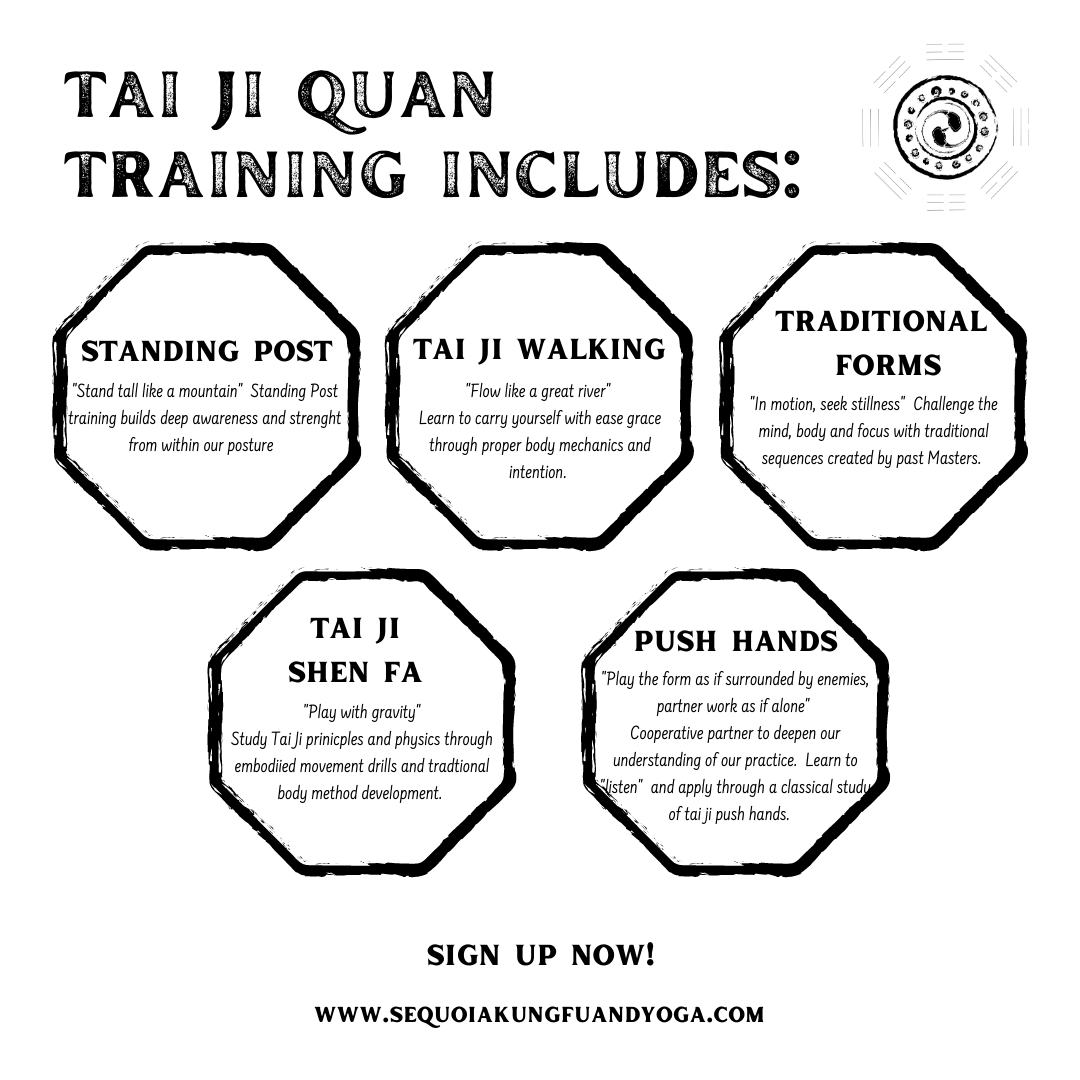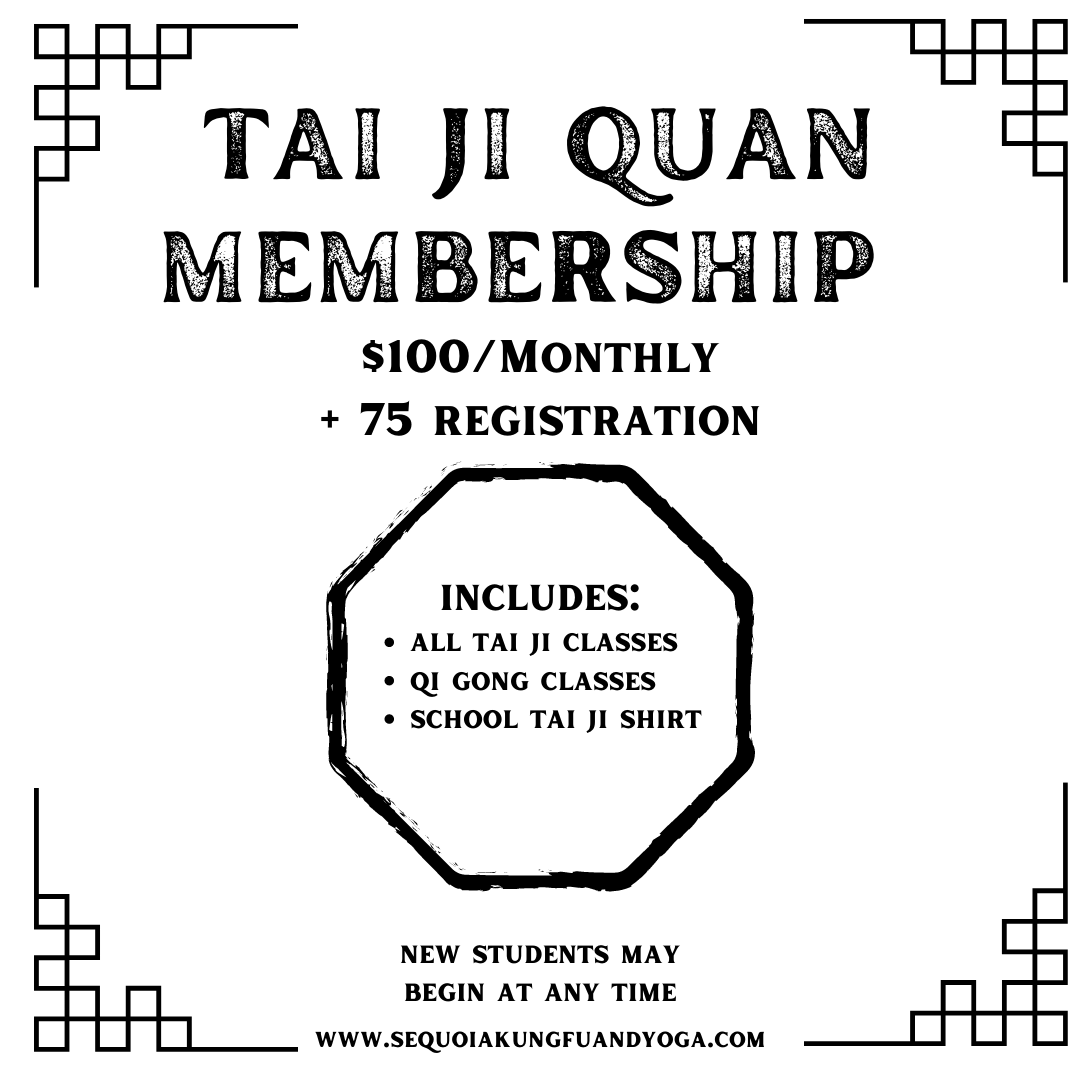Tai Ji Quan
Sometimes spelled Tai Chi, Tai Ji is an embodied movement practice with its roots in ancient China. Using simple principles and movement drills, you will discover an accessible, yet challenging practice regardless of age or physical ability.
Tai Ji is one of the most powerful tools available for creating positive change in your system. Join our program and connect to your true potentional.
Tai Ji is one of the most powerful tools available for creating positive change in your system. Join our program and connect to your true potentional.
Traditional Training for modern timesEarly Tai Ji masters were dealing with many of the same issues we deal with today. Namely, a society that was moving further away from nature and its natural movements and rhythms and more towards the repetitive and specialized patterns of the modern world.
Tai Ji training brings the body back into its own space and time through and aware based practice that brings you deeper into the mind-body experience. Start your training to day and get in touch with the motion of your life! |
Tai Ji Quan 太极拳
Tai Ji, which translates to “Grand Ultimate Fist”, is becoming more well known in the west as its health benefits are acknowledged by medical professionals. The beauty of Tai Ji is its versatility. At its roots, it is a martial art centered around self defense, but can also be practiced solely for health and meditative benefits. With its connection to Daoist philosophy the practice can also be quite cerebral.
There are many different styles of Tai Ji. Most people are familiar with the slow and gentle movements of people, both young and old, which can be found early mornings in parks not only in China, but across the world. But, there are also more physically demanding styles which place greater emphasis on strength, flexibility and coordination.
At our club we teach several different styles of Tai Ji. Yang Tai Ji, Chen Tai Ji and Zen Tai Ji.
The Yang style we teach is slow and relaxed and is better suited for those looking for a gentler and more meditative practice. It is especially beneficial for those looking to increase their balance, strength and coordination in a low impact and less intense setting. It is also a great stress reducer.
Chen Tai Ji is a much more energetic practice. Although it shares all the same principles as Yang style it can be a more complicated and physically demanding.
We do not follow a rigid curriculum, but everyone begins by learning the basic Yang 24 form. After the form is completed students have the option of continuing their practice by learning the Chen form, weapons forms and partner forms.
Our system also includes the practice of partner exercises and push hands. The partner work allows us to delve deeper into the form and to further expand our knowledge of the principles and how they shape our movement.
At our club we teach several different styles of Tai Ji. Yang Tai Ji, Chen Tai Ji and Zen Tai Ji.
The Yang style we teach is slow and relaxed and is better suited for those looking for a gentler and more meditative practice. It is especially beneficial for those looking to increase their balance, strength and coordination in a low impact and less intense setting. It is also a great stress reducer.
Chen Tai Ji is a much more energetic practice. Although it shares all the same principles as Yang style it can be a more complicated and physically demanding.
We do not follow a rigid curriculum, but everyone begins by learning the basic Yang 24 form. After the form is completed students have the option of continuing their practice by learning the Chen form, weapons forms and partner forms.
Our system also includes the practice of partner exercises and push hands. The partner work allows us to delve deeper into the form and to further expand our knowledge of the principles and how they shape our movement.
Yang Tai Ji 杨氏太极
|
|
Students of Yang Tai Ji will begin by learning what is referred to as the “Beijing 24” form. This style of Tai ji was developed to be a synthesis of the Yang style of Tai Ji and is probably the most common form of Tai ji practiced today. It is composed of slow and relaxed movements best suited for those looking for a gentle practice. We put an emphasis on relaxation and mindful movement. Classes focus on relaxation, balance, and quality movement.
|
Chen Tai Ji 陈氏太极
|
|
Thought by many to be the original style of Tai Ji, Chen Tai Ji is made up of both slow and fast movements, low and high stances and is generally more physically demanding than other forms of Tai Ji. When practicing Chen Tai Ji, you will probably sweat.
Chen Tai Ji is a complete system of solo and weapons forms, partner practice and applications. |
Da Bei Quan 大悲拳
|
|
Da Bei Quan, sometimes referred to as Zen Tai Ji, is a very rare art seldom found outside of China. It was developed as a moving meditation by Buddhist monks and is named after the Da Bei Sutra, which translates to “The Sutra of Compassion”.
While the physical practice is neither martial or religious, it is an excellent way to strengthen and stretch the body. Some describe it as not quite yoga, not quite Tai Ji, but somewhere in between. Students practice a form composed of 63 sequential movements which strengthen the legs, increase flexibility, stamina and focus. This set is especially beneficial to yoga practitioners because of the emphasis on leg strength and slow, graceful movement. |
Tai Ji Posture - A powerful exercise to reduce stress and strengthen the legs |
Why is Tai Ji Good For Balance?
|
Student resources
Beijing Tai Ji 24 Form
|
Tai Ji Warm Ups
|


